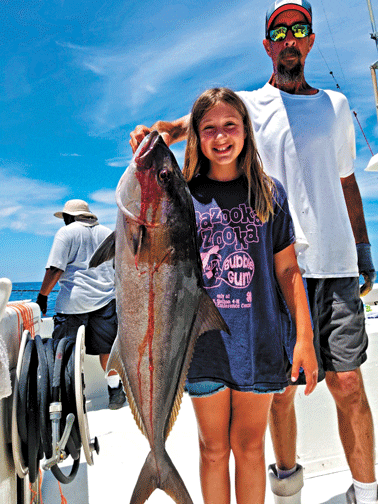Carolina Beach – July 2, 2020
Lewis, of Island Tackle and Hardware, reports that surf anglers are finding an improved flounder bite. The flatfish have been hitting live and cut bait. The beach has also been seeing some red drum, blues, croaker, and pompano.
Local piers have been landing lots of whiting, pompano, blues, trout, and some spanish.
There have been reports of red drum, black drum, and sheepshead in the Cape Fear River.
Inshore, the red drum bite has been steady. They’ve been in the ICW, around the inlet, and in the Cape Fear River. The best tactic for reds is live bait on a Carolina rig. There has also been a good topwater bite in the early mornings for reds (and sometimes trout).
Spanish are chewing hard right off the beach, with most of the action coming from the 1-3 mile range. If you head out further offshore, though, you can expect to find the larger spanish. Trolling Drones and Clarkspoons is sure to produce.
Even further offshore, mahi have been biting out around 20 miles.

Christian, of Seahawk Inshore Fishing Charters, reports that the red drum are biting. Most are just over the slot size, with only a few upper-slot and over-slot fish mixed in. The majority of the reds are falling for mud minnows and menhaden when available, and then dead shrimp at other times. Fishing Carolina rigs and jig heads on the bottom around shell beds and hard structure should produce some action.
There are black drum around, but only a few are keeper-sized. Carolina-rigged dead shrimp fished on the bottom around the lower tide stages has been the best.
Spanish can be found along the beaches whenever the conditions are right. Big Nic spanish candies have been the top producer.

Luke, of Spot On Charters, reports that if you can find good-sized mullet or menhaden, then the fish are chewing. Larger mid- to upper-slot red drum are biting north in the Cape Fear River, and large flounder are biting further south. Carolina-rigged mullet or menhaden is producing the most action for both the reds and flounder.
Nearshore wrecks are holding plenty of flounder, with an over-slot red drum mixed in here and there. Occasionally, you can also catch some blues, spanish mackerel, and sea bass. Live bait will bring in the larger nearshore fish, but if live bait isn’t available, then bucktails tipped with Gulp is a good option.
Tommy, of Mungo Fishing Charters, reports that summer fishing is finally here, and red drum, black drum, and speckled trout are the fish to target right now. Water temperatures continue to rise, so red drum are hiding in bays, deep channel drop-offs, and around oyster bars. Carolina rigged live baits on the windy days will produce, and artificial baits, soft plastics, and topwater baits will produce on calm mornings.
Speckled trout can be found in 6-8’ of water, on the 1-2’ flats, and around oyster bars. Soft plastics (like Gulp Swimming Mullet) and topwater baits (like Spook Jrs) will bring them out of hiding.
Black drum are around, and a Carolina-rigged fiddler crab will entice them (along with an occasional red drum).
Rod, of OnMyWay Fishing Charters, reports that fishing has been fantastic recently, thanks in part to a killer spanish bite right near the beach. The classic 0 or 00 Clarkspoon method has been extremely effective in 20-45’ of water outside the inlets, but primarily the fish are following the bait. Early mornings have been the most productive.
Around nearshore reefs in the 5 mile range, and then again between 25-30 miles out, anglers can find a lot of small kings (24-38”). Slow trolling dead bait has been productive, and live bait is working as well.
Mahi are biting around 35 miles out and beyond, especially on wide bottom ledges and rock areas. There have also been a few weed lines in depths of 150-300’ of water, and if you can find a weed line, you’ll find the mahi. Fast trolling gold spoons behind planers works, as does trolling small, pin-rigged ballyhoo on Blue Water Candy skirts in solid pink and pink/chartreuse.
Bottom fishing has been productive out to the 30 mile range, with plenty of beeliners, pink snapper, triggers, sea bass, and gags biting. The 20-40 mile range is holding red grouper and scamps.
The Gulf Stream has been mostly blackfin tuna, but it’s not impossible to find sailfish, mahi, and possibly a wahoo if you do your research first. The best place to look for Gulf Stream mahi is where you can see the water running. Lately it has been anywhere from 3-11 miles past the break in 900’ of water. Get the most up-to-date information (as in the night before and the morning of your trip) available about temperature breaks and rips, currents, and eddies, because conditions can change in an instant. Once you’re out there, look for color changes in the water. Cobalt blue water is preferable, as opposed to blue-green.
Woody, of Kure Beach Pier, reports that pier anglers are bringing in whiting and croakers on shrimp, along with a few red drum on cut bluefish and an occasional speckled trout.





